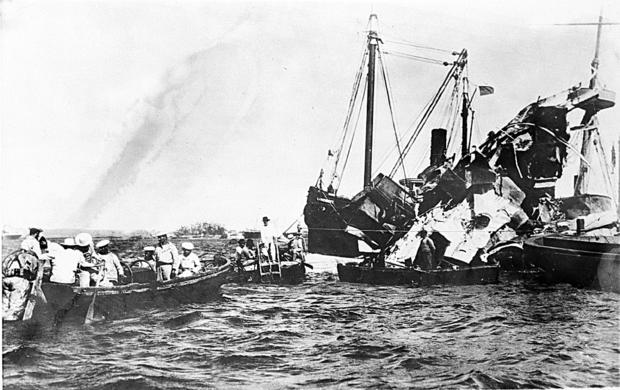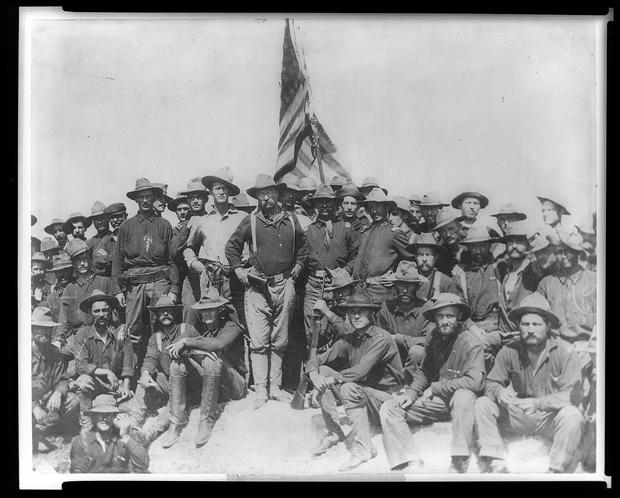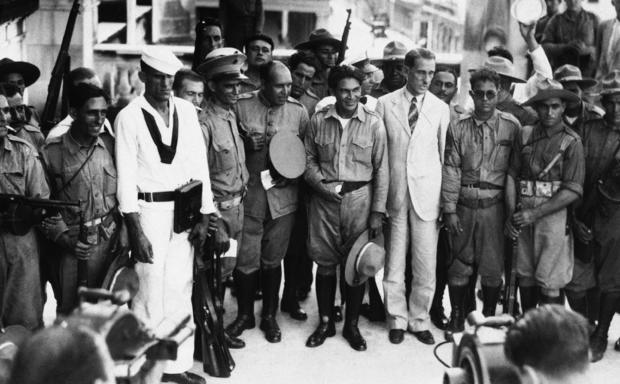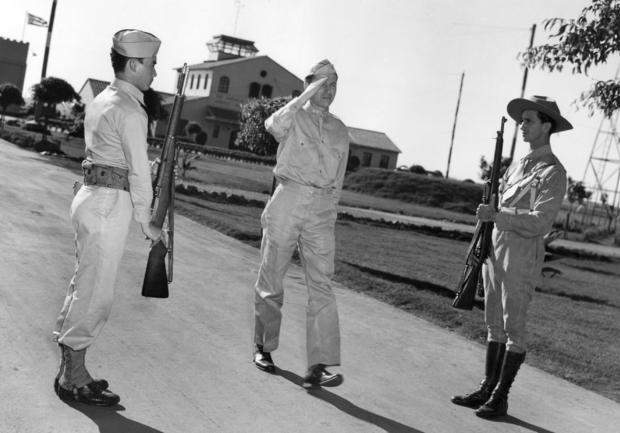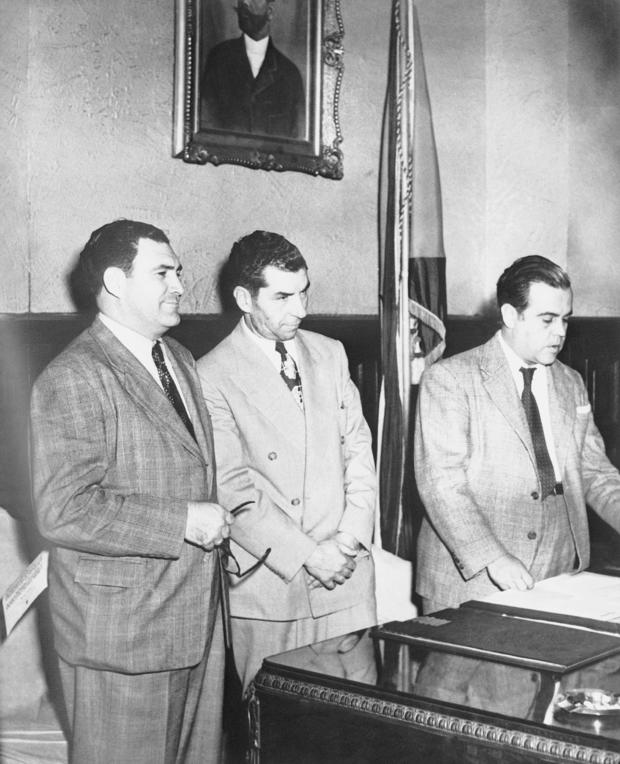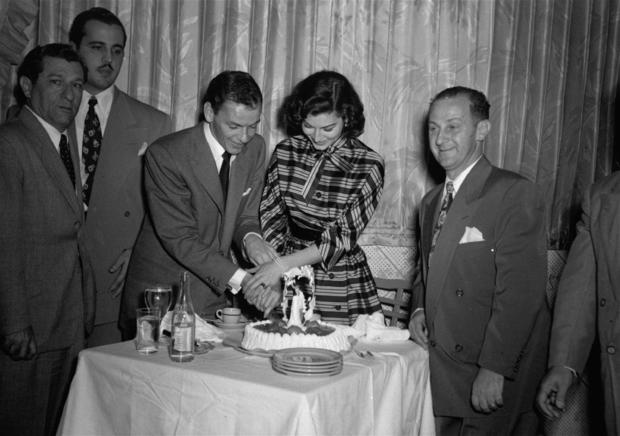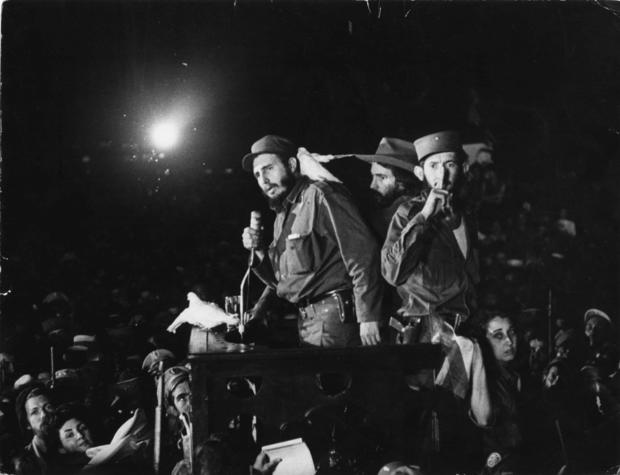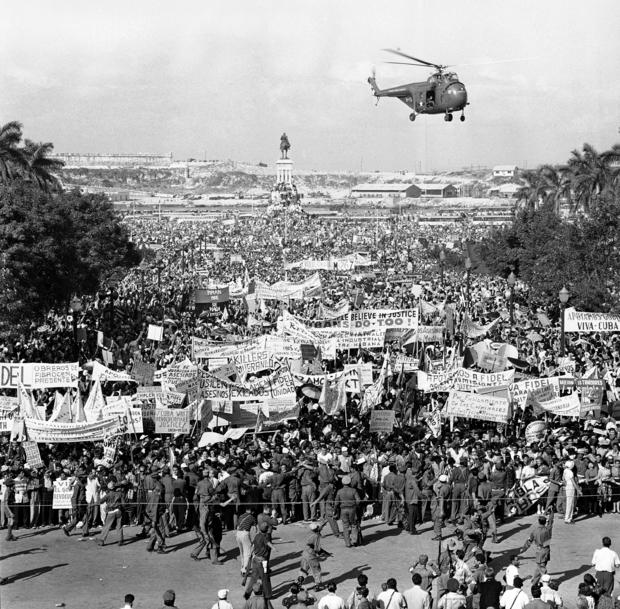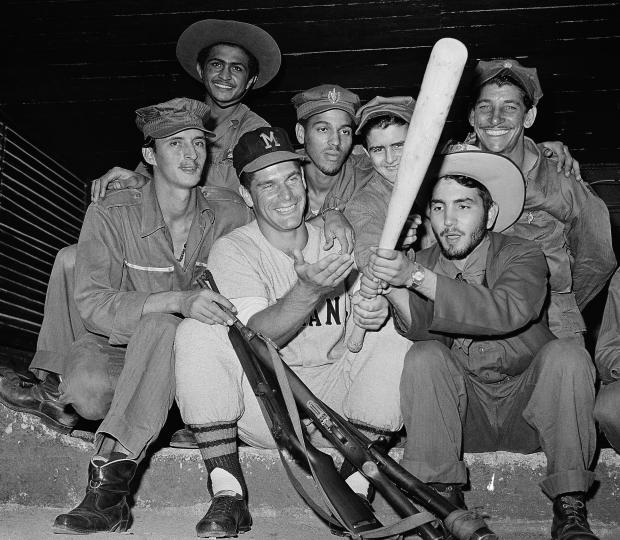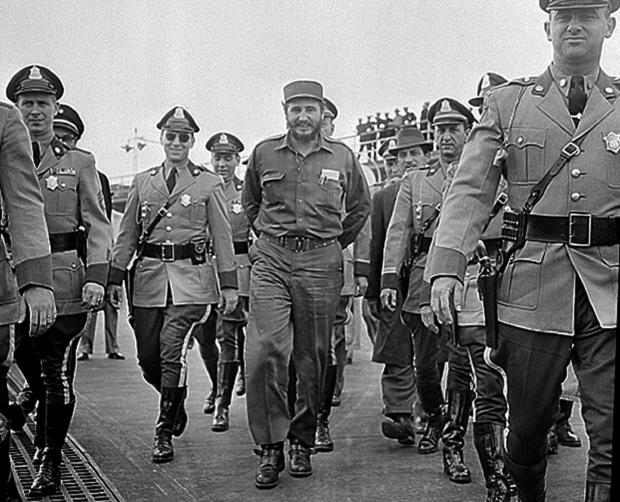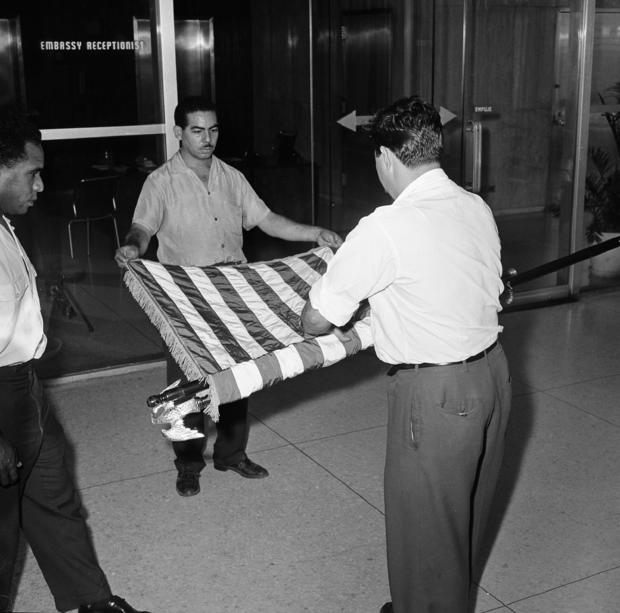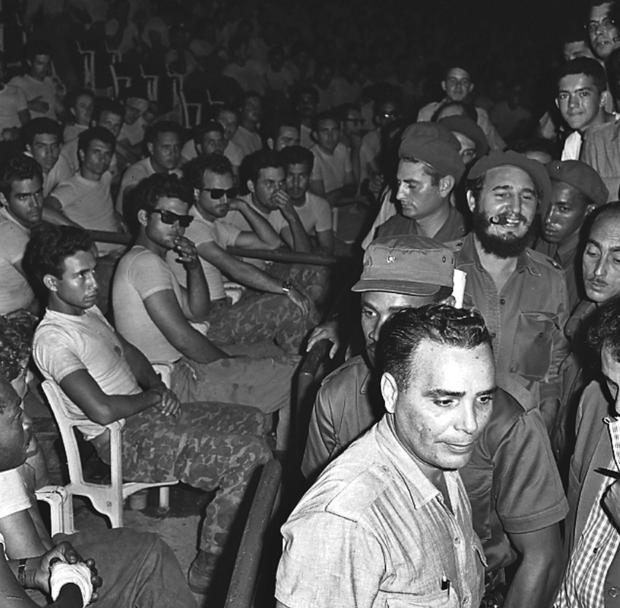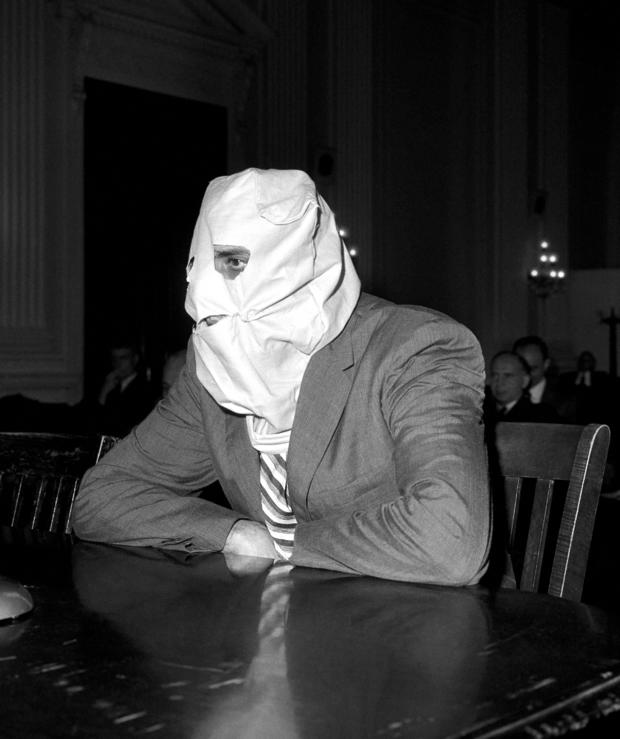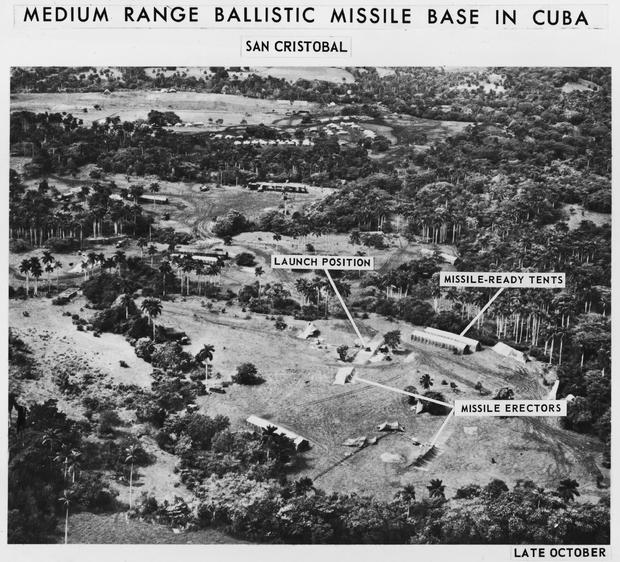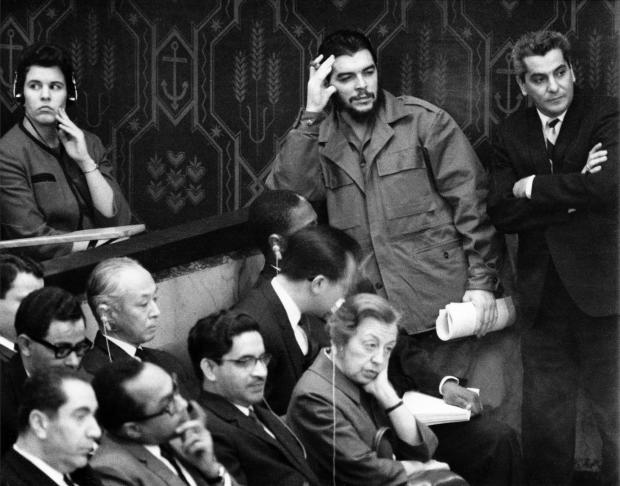The storied history of U.S.-Cuba relations
Before the U.S. and Cuba broke off diplomatic relations 54 years ago, the two countries had a long, intertwined history including leading figures such as Fidel Castro, John F. Kennedy, Ernest Hemingway, Jackie Robinson and Lucky Luciano.
On December 17, 2014, the U.S. and Cuba agreed to re-establish diplomatic relations and open economic and travel ties, marking a historic shift in U.S. policy toward the communist island after a half-century of enmity dating back to the Cold War. As President Obama makes a historic visit to CubaMarch 20-22, 2016, the first by a U.S. president in nearly nine decades, we take a look back at the storied history between the two countries the last time we had diplomatic relations with the island nation.
In this photo, U.S. President Barack Obama (R) and Cuban President Raúl Castro shake hands at the start of their meeting at the UN General Assembly in New York, September 29, 2015, another step towards a new relationship between the two countries. Two years ago, the leaders met and shook hands during the memorial service for former South African President Nelson Mandela in Johannesburg on December 10, 2013 - the first public greeting between an American president and a Cuban leader since the Cuban revolution.
By CBSNews.com senior photo editor Radhika Chalasani
USS Maine
Spain's control of Cuba strained relations with the U.S. When Cuban rebels fought colonial Spanish forces, the U.S. sent a fleet of warships to protect American lives and property on the island.
On the night of February 15, 1898, an underground explosion destroyed one of those warships -- the USS Maine -- under mysterious circumstances as it was anchored in the Havana harbor. Two hundred and sixty U.S. servicemen were killed. Spain was widely blamed in the U.S. and the event was a catalyst for the Spanish-American War. Teddy Roosevelt, then assistant Secretary of the Navy, advocated for the war that President William McKinley declared in April 24, 1898.
In this photo, lifeboats rescue surviving crewmen of the wrecked battleship.
Teddy Roosevelt & his Rough Riders
Colonel Teddy Roosevelt and his Rough Riders, The 1st U.S. Cavalry Regiment, pose at the top of the hill which they captured in the Battle of San Juan. Roosevelt resigned his position as assistant Secretary of the Navy to join the Spanish-American War as a soldier. Roosevelt was awarded the medal of Honor posthumously in 2001 for his service in Cuba.
The Battle of San Juan, won by American troops, was the decisive bloody battle of the war, July 1, 1898. The war ended on December 10 of the same year and the U.S. became a colonial power taking over Spain's holdings including Puerto Rico and Guam. The Philippines were purchased for $20 million and Cuba became an American protectorate.
President Calvin Coolidge in Cuba
U.S. President Calvin Coolidge, second from left, and his wife, first lady Grace Coolidge, third from left, are shown with the President of Cuba General Gerardo Machado y Morales, right, and his wife, Elvira Machado, far left, walk on the estate of President Machado in Havana, Cuba, Jan. 19, 1928.
Coolidge arrived in Cuba on Jan. 15 to address the sixth Pan-American Conference, his first foreign trip as president. Eighty-eight years later President Barack Obama visited Cuba.
Note: Coolidge and Morales are walking with each other's spouses.
Charles Lindbergh
Colonel Charles A. Lindbergh smiles at friends upon landing at St. Louis airfield after flying non-stop from Havana, February 29, 1928. Lindbergh was on a goodwill flight to Central and South America.
Lindbergh & American Clipper
The American Clipper, a Sikorsky S-40 amphibious plane piloted by Charles Lindbergh, rests on a stopover at Cienfuegos Bay in Cuba on November 20, 1931 en route during its maiden passenger voyage from Miami to the Panama Canal Zone. The American Clipper served as the flagship of Pan American's clipper fleet.
Fulgencio Batista
Sergeant Fulgencio Batista, center with hand on belt, seen September 7, 1933. Batista led the "Revolt of the Sergeants" in a coup against Cuban President Gerardo Machado. Machado was followed by a succession of weak leaders. Throughout, Batista continued to control the armed forces as Army Chief of Staff, effectively in control until he was elected president in 1940, serving until 1944 when his handpicked successor Carola Saladrigas Zayas took over. Batista kept a hand in Cuban politics behind the scenes while living in the U.S. for the next eight years. He staged a coup and seized power in 1952 and ran a corrupt government.
Soldiers serving together
Cuba took part in World War II on the Allied side. And during that time, U.S. troops from Puerto Rico and Cuban soldiers were drawn close together; speaking the same language; guarding the same bases; learning from the same instructors. Men from both the U.S. and Cuban armies are seen here on duty together beneath their respective flags in January 1944.
Fidel Castro
The caption describing Fidel Castro in his 1945 high school yearbook reads: "Distinguished student and a fine athlete. Very popular. Will study law and we have no doubt he will have a brilliant future."
Jackie Robinson in Havana
Jackie Robinson, minor league Montreal Royals' first baseman, shakes hands with Brooklyn Dodger manager Leo Durocher in March 1947 in Havana, where the Dodgers and Royals played an exhibition game.
The Dodgers had set up training camp in February in Havana, giving Robinson time to prepare in relative obscurity for his entry into Major League Baseball. Blacks had been playing in the professional winter league in Cuba for some time. Robinson would break the U.S. color barrier in the sport later that year as the the first African-American player.
"Lucky" Luciano
Charles "Lucky" Luciano, (center), one-time New York racketeer, flanked by Benito Herrera, (left), Chief of the Cuban Secret Police, and Alfredo Pequeno, Minister of the Interior, is arrested in Havana on February 22, 1947 and deported to Italy.
Mobster Luciana received parole and a deportation order from the U.S. in early 1946. He went back to Italy for a short time and then ended up in Cuba. Luciano was thought to have arranged the Havana Conference at the Hotel Nacional in December 1946, an important summit of both U.S. mafia and Cosa Nostra leaders. One of the many topics discussed, reportedly, was the global narcotics trade and mob operations in America, with Luciano playing an integral role. The U.S. forced the Cuban deportation order by temporarily banning shipments of drugs and medical supplies to Cuba.
Sinatra & Gardner honeymoon
Frank Sinatra and his new bride, movie actress Ava Gardner, join hands as they cut a wedding cake in the Montmarte, a Havana nightclub on November 8, 1951. Married on November 7, in Philadelphia, they went to Havana on a whirlwind honeymoon.
Havana was a cosmopolitan seaside capital, a winter refuge for Americans who came to gamble, golf and socialize. Tourism was at its height.
Gambling in Havana
Americans and Cubans crowd a Havana casino's roulette wheel, February 9, 1956. Batista promoted large-scale gambling in Havana and the capital was known as the Las Vegas of the Caribbean. Batista collected a substantial portion of the profits.
Fidel Castro at Ciudad Libertad
Cuba's Fidel Castro speaks to supporters at the Batista military base Columbia, now known as Ciudad Libertad, in Cuba, January 8, 1959.
The Cuban revolution triumphed on January 1, after dictator Fulgencio Batista fled the country and Castro and his band of rebels descended from the island's eastern mountains, where they waged a guerrilla war against government troops.
The United States soon recognized the new government.
Fidel Castro 1959
A crowd jammed Central Park in front of the Presidential Palace to hear Fidel Castro defend his regime against criticism regarding summary trials and executions of Batista loyalists in Havana, January 21, 1959.
The crowd, which stopped all pedestrian and auto traffic for six blocks either side of the park, was estimated at one million people. In background is the statue of Maximo Gomez, a Cuban Independence hero.
Cuban winter league
A rebel solider from Fidel Castro's army holds the bat of Charley Lau, a Detroit player taking part in the Cuban winter league in Havana, February 1, 1959. Baseball had long been popular in the island nation, even before American intervention, in part, as a symbol of independence from colonial Spanish rulers who preferred bullfighting. Though Castro sought to promote nationalism with baseball, but he banned all professional sports in 1962 favoring a system of amateur baseball leagues for a more socialist model.
Cuban-Americans
These residents of Ybor City, Tampa's heavily Cuban-American area, gathered on the steps of the Cuban club after learning Cuba's President Fulgencio Batista fled Havana, January 1, 1959. Batista fled into exile December 31.
Fidel Castro in Boston
Fidel Castro, sworn in as Prime Minister of Cuba February 16 1959, is escorted by Massachusetts State Police as he walks to an airplane at Logan Airport in Boston for a flight to Montreal in April 26, 1959.
The Cuban leader was in Boston to speak at the Harvard Law School forum under heavy police guard since authorities feared a possible assassination.
Hemingway & Castro
American author Ernest Hemingway (left) and Cuban Prime Minister Fidel Castro chat in Havana, May 15, 1960, 14 months before Hemingway's death.
Hemingway traveled to Cuba for the first time in 1928. He later made his home on the island from 1939 to 1960 and wrote seven of his novels there, including "The Old Man and the Sea" and "A Moveable Feast." His Cuban home, Finca Vigía, was turned into a museum.
International League 1960
Cuban leader Fidel Castro tosses the traditional first ball at ceremonies opening the International League baseball season in Havana, April 20, 1960. At right, is Rochester Red Wings manager Clyde King, whose Redwings met the 1959 Little World Series champion Havana Sugar Kings, in the season opener.
In June 1960, the Red Wings were the last American ball club to play a regulation game in Cuba until the Baltimore Orioles played an exhibition game in Havana in 1999.
By 1960, the Cold War was in full force and Castro aligned himself with the USSR. The Cuban leader nationalized U.S.-owned assets in the country.
U.S. embassy in Cuba 1961
U.S. embassy employees roll up a U.S. flag as the embassy transfers American affairs to the Swiss government, in Havana, January 7, 1961.
Two years after recognizing Castro's government, the U.S. broke off relations with Cuba on January 3, 1961 and closed its embassy.
Bay of Pigs trial
Cuban President Fidel Castro (3rd row, R) enters a public trial for captured members (seated) of the failed Bay of Pigs invasion in Havana on April 1961.
Castro declared Cuba a socialist state on April 16, 1961. Fifteen hundred Cuban exiles, organized and armed by the CIA, came ashore April 17 in an unsuccessful attempt to overthrow Castro's government. The invaders never got beyond the mosquito-infested swamps surrounding the Bay of Pigs, as Castro's fledgling revolutionary government scrambled to defend itself.
Cuban pilot seeks asylum
Customs officials look over the bullet-riddled Cuban Air Force B-26 which landed in Miami on April 15, 1961, after taking part in air attacks on the airports in Havana and Santiago, Cuba. The pilot, who flew the plane alone, asked the U.S. Immigration Service for political asylum.
Cuban refugee doctor
A masked witness, who identified himself as a Cuban refugee doctor, appears before the House Committee on Un-American Activities in Washington on November 15, 1962.
The witness who said he fled Cuba seven or eight months before, told the committee he wore the mask because he feared relatives in Cuba might be harmed if his identity became known.
Cuban Missile Crisis
A spy photo of a medium range ballistic missile base in San Cristobal, Cuba, with labels detailing various parts of the base, is shown October 1962.
Evidence of missiles in Cuba led to a thirteen day standoff with a U.S. military blockade of Cuba to force the removal of the missiles from October 16-28, 1962, keeping the world worried the clash would escalate to nuclear war.
President John F. Kennedy
U.S. President John Fitzgerald Kennedy signs the order of naval blockade of Cuba on October 24, 1962 at the White House in Washington D.C., during the Cuban missiles crisis.
On October 22, 1962, President Kennedy informed the American people of the presence of missile sites in Cuba. The tense situation ended with the Soviets removing the missiles in exchange for a U.S. promise to not invade Cuba without direct provocation.
Che Guevara
Cuba's Minister of Industry Ernesto "Che" Guevara, smoking a cigar in uniform, leans against a wall in the spectator's gallery in the United Nations Security Council chamber as he listens to a speech by U.S. ambassador to the UN. Adlai Stevenson, December 14, 1964.
Cuba had no seat in the Security Council and Guevara had to stand when there were no more chairs for spectators. Che accused the U.S. of planning on attack on Cuba in a speech at the UN. Stevenson denied the accusation.
Decades of animosity between the two countries ensued until U.S. President Obama and Cuban President Raúl Castro surprised the world in December 2014, announcing they had agreed to restore diplomatic relations.

